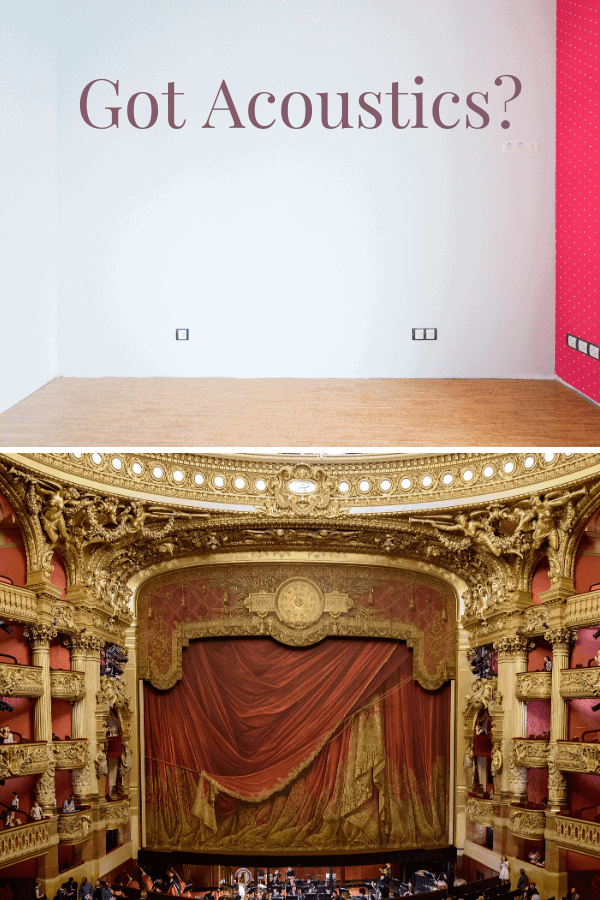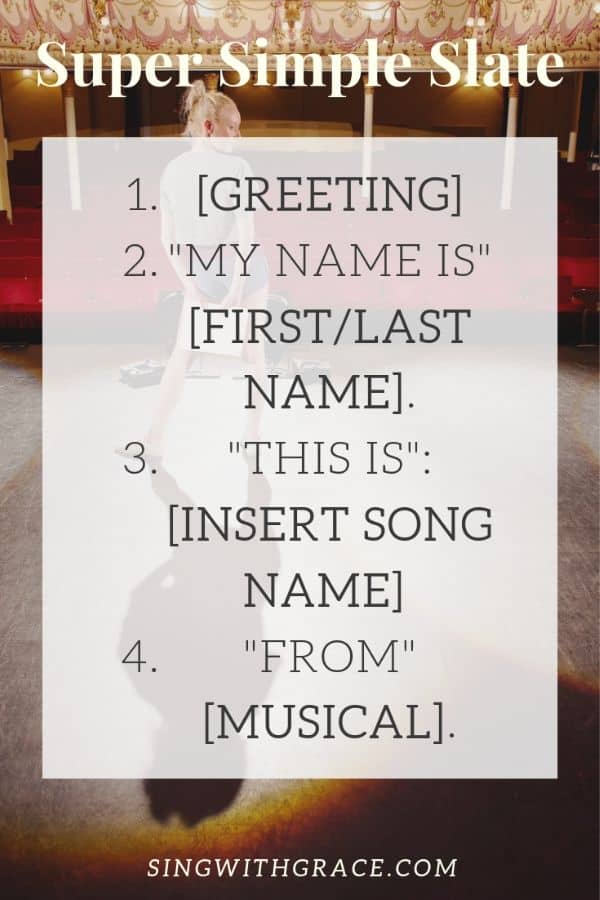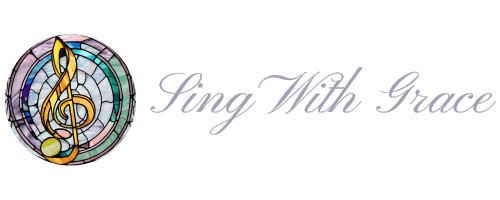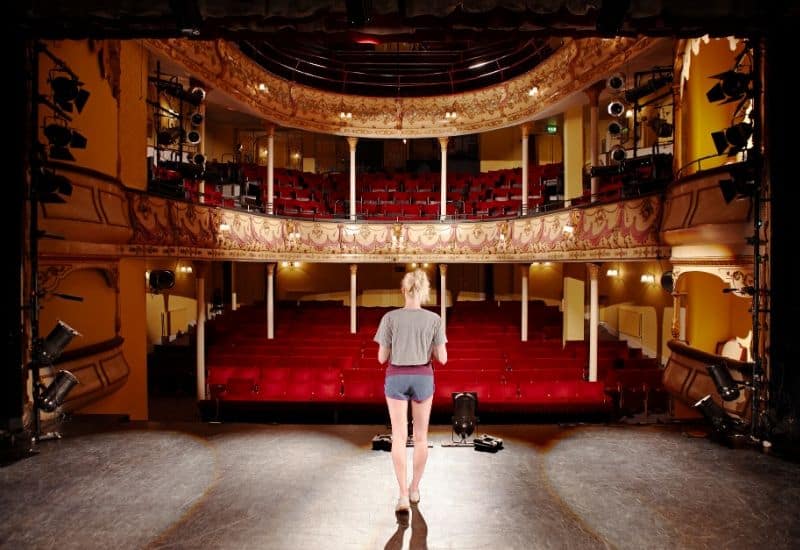What is an audition slate? It is the way you introduce yourself to the director panel! Usually this panel consists of the show’s director, musical director, and whomever else is included in the casting decision (I’ve seen producers, stage managers, and even lead actors be part of the decision).
Even though you might have submitted your headshot and resume and/or a pre-audition information sheet, it is important to let the panel know who you are and what you’re singing.
As a bonus, when saying your slate you have an opportunity to show them your personality and get acclimated to the space. I consider the entire time from when you enter the audition space to when you hit your first note to be your “slate.” Everything you exude flavors how the panel will experience your performance.
Think About Acoustics.
It’s very important to feel how your voice sounds in a space. When you state your slate, you are given an opportunity to test the acoustics specific to the audition room.
I have auditioned on stage in the main theatre with all of the auditioners and panel watching me. Alternatively, I have auditioned in a small, carpeted 8’x8’ room five feet away from the director’s table. The sound in these rooms will “feel” very different. Your voice will resonate in different ways. Once you stand on that X, any speaking you do gives an insight into how your singing voice will carry.

If the room is large with not many dampening things like carpets and soundproofing walls (those big square carpeted things), it is considered a “live” room. Basically all that means is your voice will travel and bounce off all the walls if you project! If you do not use enough air to support your sound, it might get swallowed up by the space.
If the room is small with lots of carpet, you will not need a lot of volume, but you still need to support your sound.
So with all of that in mind, let’s begin writing your slate!
1. First Impressions
(Usually) the first thing you will do when going into the audition room/onstage is head to the accompanist.
If you don’t have an audition cut with sheet music, plug in your device to a speaker or hand it to whoever will run the accompaniment sound for you. I do not recommend singing your audition cut a capella unless they specifically request for you to do so. In general, hearing the rhythm and pitch in relation to the music is crucial for judging your singing ability. Great pitch is not very useful if you can’t keep in time!
Smile at the panel and if they say good morning/ evening, say it back to them! Don’t get tunnel vision and forget to be polite. These folks want to work with awesome, kind people like you! Let them know from the start that you’re the kind of person–even in a stressful situation–that will remain positive.
If you have a more serious personality, feel free to let that shine as well. There’s nothing wrong with not being peppy, just make sure you are making the decision to positively share your personality with the panel of directors!
The next part of your first impression is confidently and concisely explaining your cut to the accompanist. Sometimes the theatre company allows you to practice before. It’s always a good idea to remind the accompanist of the parts of your cut (check out this post if you need help choosing and marking your cut).
Explaining Your Cut
Introduce yourself!
“Hi, I’m [insert name here]. I’ll be singing [insert song name] from/by [insert musical/artist name].
- While introducing yourself, hand them your music binder already turned to your first page of sheet music.
- Point out the START, any special notes along the way (repeats, key changes, etc) and the END.
“Here is where I would like to start. I will be taking this repeat here at measure [bar number] back to here [bar number]. There is a key change here. And my cut ends right here!”
At this point, the accompanist will probably ask you what tempo you are taking it at. It’s customary to quietly (so that the pianist can hear you!) sing a couple of measures of your audition cut so that the accompanist can get a feel of what tempo you are taking it at.
It is important that you do not show them a tempo that is too fast or too slow because of nerves!
BEFORE you get to the audition, make sure you are completely comfortable with sharing your starting tempo. If your nerves are affecting your thought processes (happens to us all), go a bit slower. A bit of a speedup is easier for an accompanist to follow than a slow down!
Thank your accompanist! You want to make a good, professional impression on everyone. Oftentimes the music director is the pianist accompanying you–he/she might have a say in who gets called back or not!
2. X Marks the Spot
This is the easy part. Walk confidently, still happy to be there, from the piano to wherever the panel prefers you to stand. If there is an X on the floor, stand on it! If not, stand at least 5-8 feet away from the directors (if you’re uncomfortable with your distance, they might be too).
Don’t be alarmed if they ask you to adjust your position (left/ right/ forward/ backward). Just smile and comply. 🙂
Look at the judges and see if they are still writing or discussing from the last audition. Don’t interrupt them if they are! Usually they’ll look at you when they are ready. Sometimes they will say something to you . . . answer their questions! If they ask you your name or what song you’re singing–it’s time to slate!
3. Slay Your Slate
Here is my formula for slating:
Hi! My name is [first name last name], and [I will be singing / this is] [insert song name] from/by [musical /artist name].

That’s all! Some important notes on your slate:
- Speak up! Make sure the panel doesn’t have to strain to hear you.
- Slow down! Clearly pronounce all of your words . . . especially your name!
- Be alive! Don’t just *angrily murmur* your slate😂. Put a little pep or sarcasm or whatever you are like into your slate. They want to see what you are like!
After slating they might say “okay” or “you may begin” or they might not say anything.
Go ahead and make eye contact with the accompanist, smile, nod your head, and the audition begins!
Break a leg!
Grace Brown


Pingback: 10 Confidence Boosters for Musical Theatre Auditions : Sing With Grace